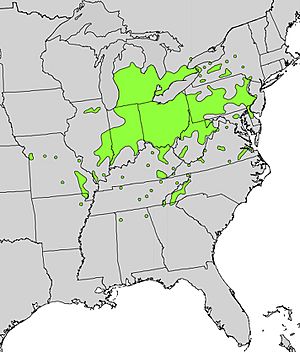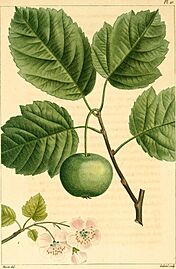Malus coronaria facts for kids
Quick facts for kids Malus coronaria |
|
|---|---|
 |
|
| The flowers of Malus coronaria. | |
| Conservation status | |
| Scientific classification | |
| Genus: |
Malus
|
| Species: |
coronaria
|
 |
|
| Natural range | |
| Synonyms | |
|
|
The sweet crabapple, also called the garland crab, is a type of crabapple tree. It grows naturally in North America. Its scientific name is Malus coronaria.
Contents
Description
The sweet crabapple often looks like a bushy plant with stiff, twisted branches. It can also grow into a small tree, reaching up to 10 meters (about 33 feet) tall. These trees have a wide, open top.
Its flowers bloom about two weeks later than regular apple trees. The sweet-smelling fruit stays on the branches in bunches long after the leaves have fallen off.
Bark and Branches
The bark of the sweet crabapple is reddish-brown. It has cracks that run up and down, and its surface peels off in thin pieces. Young branches are first covered with thick white fuzz. Later, they become smooth and reddish-brown.
By their second year, these branches grow long, spur-like twigs. Sometimes, they even grow sharp thorns that can be 2.5 centimeters (about 1 inch) or longer.
Wood
The wood of this tree is reddish-brown with yellow sapwood. It is heavy and has a tight grain, but it is not very strong. People have used this wood to make tool handles and small items for the home.
Winter Buds and Leaves
In winter, the buds are bright red and very tiny. The inner parts of the buds grow with the new shoots. They become about 13 millimeters (0.5 inches) long and bright red before they fall off.
The leaves grow in an alternating pattern along the branch. They are simple, oval-shaped, and measure about 7.5 to 10 centimeters (3 to 4 inches) long. They are usually 4 to 5 centimeters (1.5 to 2 inches) wide.
The leaves are often rounded or heart-shaped at the bottom and pointed at the top. They have jagged edges and are sometimes three-lobed on strong new shoots. When they first appear, they are reddish-bronze and fuzzy. As they grow, they become bright dark green on top and lighter underneath. In autumn, they turn yellow.
Flowers
Sweet crabapple flowers bloom from May to June, when the leaves are almost fully grown. They are perfect flowers, meaning they have both male and female parts. They are rose-colored and smell wonderful, measuring 4 to 5 centimeters (1.5 to 2 inches) across.
The flowers grow in clusters of five or six, on thin stems. The cup-shaped part of the flower, called the calyx, is fuzzy and has five pointed lobes. There are five rose-colored petals, which are rounded at the top and have long, narrow bases.
Each flower has 10 to 20 stamens, which are shorter than the petals. The pistil, the female part, has five sections joined together.
Fruit
The fruit is a type of apple called a pome, and it ripens in October. It is round and flattened, measuring 2.5 to 4 centimeters (1 to 1.5 inches) across. The fruit is topped with the remains of the calyx and stamens.
It is yellow-green and has a delightful smell, sometimes with a waxy surface. The inside of the fruit is white and soft, full of malic acid, which gives it a tart taste. Each fruit contains one or two shiny, chestnut-brown seeds.
-
Tree in New Hampshire
Taxonomy
Scientists have identified two main types, or varieties, of Malus coronaria:
- Malus coronaria var. coronaria
- Malus coronaria var. dasycalyx
Distribution and habitat
This sweet crabapple species mainly grows around the Great Lakes Region and in the Ohio Valley in North America. You can also find smaller groups of these trees as far away as Alabama, eastern Kansas, and Long Island. It prefers to grow in rich, moist soil.
Uses
The fruit of the sweet crabapple can be used to make preserves and cider. Pehr Kalm, a student of the famous botanist Carl Linnaeus from the 1700s, wrote about the fruit:
The apples, or crabs, are small, sour and unfit for anything but to make vinegar of. They lie under the trees all winter and acquire a yellow color. They seldom begin to rot before spring comes on.
See also
 In Spanish: Manzano silvestre americano para niños
In Spanish: Manzano silvestre americano para niños






